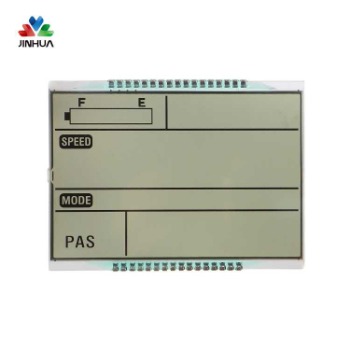LCD display mode
As far as display modes are concerned, there are two types of LCDs, positive LCD and negative LCD.
Positive display mode
The image on the LCD monitor is transparent when the pixel is "OFF". When a pixel is "ON", it is opaque. This operating mode is mainly used in places with strong ambient light. And it will help with monitor contrast, especially for monitors using reflective rear polarizers. For example, alphanumeric characters on a larger background. The segments or dots on the character will absorb the light (appearing dark), while the background will reflect the light to enhance the character. Here are a few typical Operation Mode and View Mode combinations and the resulting images:
TN: black characters on gray background
STN-Green: Dark purple/black characters on a green background.
STN-Silver: dark blue/black characters, silver background
FSTN: black characters on white/grey background
Negative display mode
A negative image on an LCD display is opaque when a pixel is "OFF". When a pixel is "ON", it is transparent. In this mode, the portion of the display that reflects light and gives character definition is minimized. Therefore, this mode is typically used when there is a backlight and the ambient lighting conditions are dim. With a backlight, the transparent parts of the display will "glow". Backlight can pass through the area when the pixel is turned on, and high ambient light can wash out the backlight. Here are a few typical Operation Mode and View Mode combinations and the resulting images (assuming a backlight with the specified color is listed):
TN: Glowing green-yellow characters on a light gray background (yellow-green backlight)
STN ("Blue Negative"): glowing yellow-green characters on a light blue background (yellow-green backlight)
FSTN: Illuminated white characters on black background (white backlight)
LCD polarizer
Each LCD has 2 polarizers, front and back. They are attached to the front of the display viewing surface and to the back of the display to determine how light is directed into the LCD screen. The front polarizer is always transmissive and cannot be changed by the user, but there are three options for the rear polarizer.
Transmissive polarizer
Transmissive rear polarizers are used in dark environment applications that require backlighting and can maximize the brightness of the backlight. Most (but not all) transmissive displays are negative images, and we sometimes add color filters to certain areas of the display to highlight different annunciators. Another example of a transmissive polarizer display is a transparent window where you can see segments overlapping your line of sight through the display window (like in a science fiction movie).
Reflective polarizer
Reflective displays have a clear rear polarizer and include a diffuse reflector. They are used in applications without backlight due to insufficient backlight power or ambient light intensity. They are particularly suitable for use in battery-operated devices that always provide a sufficient level of external light.
Semi-transmissive type
Transflective displays have a back polarizer that includes a translucent material. And it reflects part of the ambient light and also transmits the backlight. Therefore, when the backlight is turned on, the image can be viewed in high or low ambient light.






 English
English Deutsch
Deutsch русский
русский español
español العربية
العربية



 IPv6 network supported
IPv6 network supported
